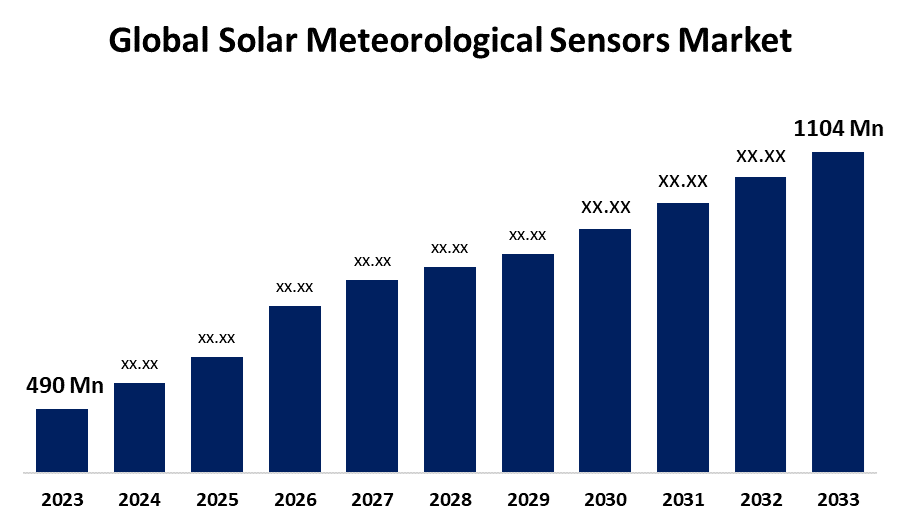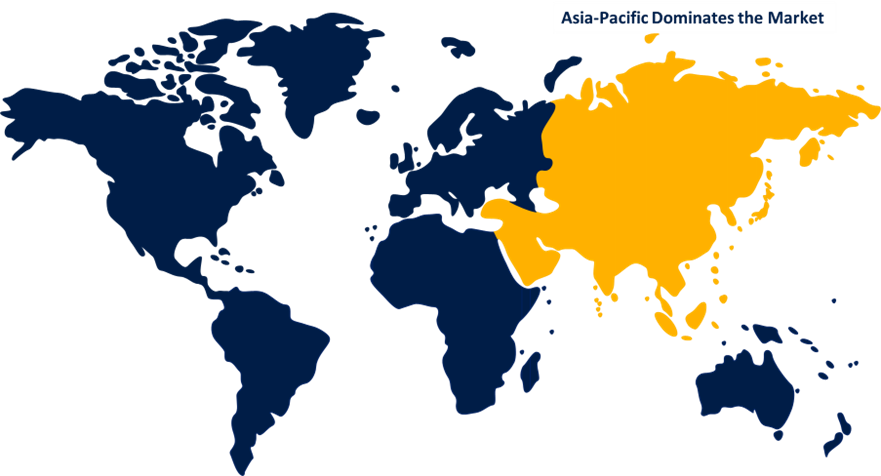Global Solar Meteorological Sensors Market Size, Share, and COVID-19 Impact Analysis, By Sensor Type (Pyranometers, Pyrheliometers, and Radiometers), By Application (Weather Forecasting, Solar Power Generation, and Climate Research), and By Region (North America, Europe, Asia-Pacific, Latin America, Middle East, and Africa), Analysis and Forecast 2023 - 2033.
Industry: Semiconductors & ElectronicsGlobal Solar Meteorological Sensors Market Insights Forecasts to 2033
- The Global Solar Meteorological Sensors Market Size was estimated at USD 490 Million in 2023
- The Market Size is Expected to Grow at a CAGR of around 8.46% from 2023 to 2033
- The Worldwide Solar Meteorological Sensors Market Size is Expected to Reach USD 1104 Million by 2033
- North America is expected to grow the fastest during the forecast period.

Get more details on this report -
The Global Solar Meteorological Sensors Market Size is expected to cross USD 1104 Million by 2033, growing at a CAGR of 8.46% from 2023 to 2033.
Market Overview
The business that produces, distributes, and uses sensors that detect different meteorological characteristics to maximize solar energy generation is known as the solar meteorological sensors market. The solar meteorological sensors market is essential for tracking weather patterns that affect solar power systems' effectiveness and performance, allowing for improved energy management and forecasting for solar energy projects. The sensors, systems, and services that support rooftop solar installations, solar power plants, and associated applications are all included in the solar meteorological sensor market. The increase in solar power generation capacities, the growing need for climate research tools, and the growing demand for precise weather forecasts are the main factors driving the growth of the solar meteorological sensors market. Innovations in technology, like the incorporation of artificial intelligence (AI) and the Internet of Things (IoT) into sensor systems, are driving growth in the market. The growing focus on the use of renewable energy, especially solar electricity, worldwide is the main factor driving the solar meteorological sensors market.
Report Coverage
This research report categorizes the solar meteorological sensors market based on various segments and regions forecasts revenue growth and analyzes trends in each submarket. The report analyses the key growth drivers, opportunities, and challenges influencing the solar meteorological sensors market. Recent market developments and competitive strategies such as expansion, type launch, development, partnership, merger, and acquisition have been included to draw the competitive landscape in the market. The report strategically identifies and profiles the key market players and analyses their core competencies in each sub-segment of the solar meteorological sensors market.
Solar Meteorological Sensors Market Report Coverage
| Report Coverage | Details |
|---|---|
| Base Year: | 2023 |
| Market Size in 2023 : | USD 490 Million |
| Forecast Period: | 2023 – 2033 |
| Forecast Period CAGR 2023 – 2033 : | 8.46% |
| 023 – 2033 Value Projection: | USD 1104 Million |
| Historical Data for: | 2019-2022 |
| No. of Pages: | 220 |
| Tables, Charts & Figures: | 118 |
| Segments covered: | By Application, By Sensor Type and By Region |
| Companies covered:: | AEMET, Vaisala Corporation, Apogee Instruments, Campbell Scientific Inc., Kipp & Zonen, Delta-T Devices Ltd., Hukseflux, LI-COR Biosciences, Inc., Radiometer Copenhagen A/S, Meteo-Systeme M®unchen GmbH, |
| Pitfalls & Challenges: | COVID-19 Empact,Challenges, Future, Growth, & Analysis |
Get more details on this report -
Driving Factors
Improvements in sensor technology, like increased precision and the ability to integrate with digital platforms, are increasing the devices' appeal to the public and private sectors, which is driving the growth of the solar meteorological sensors market. Increased use of solar energy, government initiatives supporting renewable energy, technological developments, the demand for precise weather data, and integration with smart grid systems for optimal energy production are all factors driving the solar meteorological sensors market. One of the main drivers is the increasing use of smart grid technology, which enables real-time data management and collection.
Restraining Factors
The market for solar meteorological sensors is facing various restrictions despite its bright future, chiefly the high upfront expenses of installing and maintaining these cutting-edge sensor systems.
Market Segmentation
The solar meteorological sensors market share is classified intosensor type and application.
- The pyranometers segment held the largest share in 2023 and is expected to grow at a significant CAGR during the forecast period.
Based on the sensor type, the solar meteorological sensors market is divided into pyranometers, pyrheliometers, and radiometers. Among these, the pyranometers segment held the largest share in 2023 and is expected to grow at a significant CAGR during the forecast period. Pyranometers are a common tool for measuring sun irradiance worldwide and are crucial for solar power generation and weather forecasting.
- The solar power generation segment held the largest share in 2023 and is expected to grow at a significant CAGR during the forecast period.
Based on the application, the solar meteorological sensors market is divided into weather forecasting, solar power generation, and climate research. Among these, the solar power generation segment held the largest share in 2023 and is expected to grow at a significant CAGR during the forecast period. Solar power generation sensors give real-time information on temperature, sun irradiance, and other environmental conditions, which helps solar panels operate at their best.
Regional Segment Analysis of the Solar Meteorological Sensors Market
- North America (U.S., Canada, Mexico)
- Europe (Germany, France, U.K., Italy, Spain, Rest of Europe)
- Asia-Pacific (China, Japan, India, Rest of APAC)
- South America (Brazil and the Rest of South America)
- The Middle East and Africa (UAE, South Africa, Rest of MEA)
Asia Pacific is anticipated to hold the largest share of the solar meteorological sensors market over the predicted timeframe.

Get more details on this report -
Asia Pacific is anticipated to hold the largest share of the solar meteorological sensors market over the predicted timeframe. The Asia-Pacific region is characterized by the rapid expansion of solar energy in nations such as China and India, with the latter requiring sophisticated sensor technologies to support large-scale solar projects due to its ambitious solar targets under the National Solar Mission. China leads the world in solar installations, which greatly increases the need for accurate meteorological data to maximize energy production, according to the International Renewable Energy Agency (IRENA).
North America is expected to grow at the fastest CAGR growth of the solar meteorological sensors market during the forecast period. In North America, the US is making significant investments in research and infrastructure related to renewable energy, helped by DOE projects. The demand for accurate meteorological data to maximize solar energy generation is being driven by the ongoing growth in solar energy projects, particularly in the United States and Canada.
Competitive Analysis:
The report offers the appropriate analysis of the key organizations/companies involved within the solar meteorological sensors market along with a comparative evaluation primarily based on their type of offering, business overviews, geographic presence, enterprise strategies, segment market share, and SWOT analysis. The report also provides an elaborative analysis focusing on the current news and developments of the companies, which includes type development, innovations, joint ventures, partnerships, mergers & acquisitions, strategic alliances, and others. This allows for the evaluation of the overall competition within the market.
List of Key Companies
- AEMET
- Vaisala Corporation
- Apogee Instruments
- Campbell Scientific Inc.
- Kipp & Zonen
- Delta-T Devices Ltd.
- Hukseflux
- LI-COR Biosciences, Inc.
- Radiometer Copenhagen A/S
- Meteo-Systeme M®unchen GmbH
- Others
Key Target Audience
- Market Players
- Investors
- End-users
- Government Authorities
- Consulting And Research Firm
- Venture capitalists
- Value-Added Resellers (VARs)
Recent Development
- In October 2024, Southwest Research Institute (SwRI) researchers launched the Solar Wind Plasma Sensor (SWiPS), a novel device designed to improve space weather observation. SWiPS is intended to detect solar wind ion characteristics, namely those related to coronal mass ejections (CMEs), and is integrated into the Space Weather Follow On-Lagrange 1 (SWFO-L1) satellite operated by the National Oceanic and Atmospheric Administration (NOAA).
Market Segment
This study forecasts revenue at global, regional, and country levels from 2023 to 2033. Spherical Insights has segmented the solar meteorological sensors market based on the below-mentioned segments:
Global Solar Meteorological Sensors Market, By Sensor Type
- Pyranometers
- Pyrheliometers
- Radiometers
Global Solar Meteorological Sensors Market, By Application
- Weather Forecasting
- Solar Power Generation
- Climate Research
Global Solar Meteorological Sensors Market, By Regional Analysis
- North America
- US
- Canada
- Mexico
- Europe
- Germany
- UK
- France
- Italy
- Spain
- Russia
- Rest of Europe
- Asia Pacific
- China
- Japan
- India
- South Korea
- Australia
- Rest of Asia Pacific
- South America
- Brazil
- Argentina
- Rest of South America
- Middle East & Africa
- UAE
- Saudi Arabia
- Qatar
- South Africa
- Rest of the Middle East & Africa
Frequently Asked Questions (FAQ)
-
1. What is the CAGR of the solar meteorological sensors market over the forecast period?The solar meteorological sensors market is projected to expand at a CAGR of 8.46% during the forecast period.
-
2. What is the market size of the solar meteorological sensors market?The Global Solar Meteorological Sensors Market Size is Expected to Grow from USD 490 Million in 2023 to USD 1104 Million by 2033, at a CAGR of 8.46% during the forecast period 2023-2033.
-
3. Which region holds the largest share of the solar meteorological sensors market?Asia Pacific is anticipated to hold the largest share of the solar meteorological sensors market over the predicted timeframe.
Need help to buy this report?